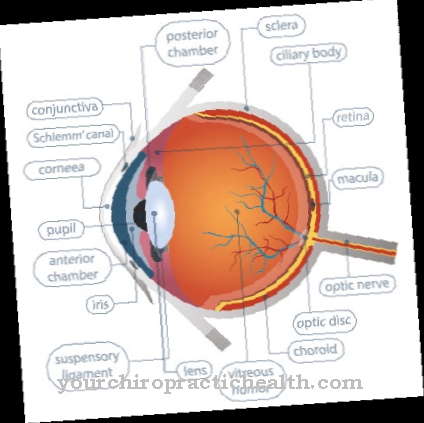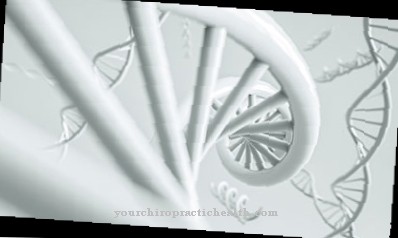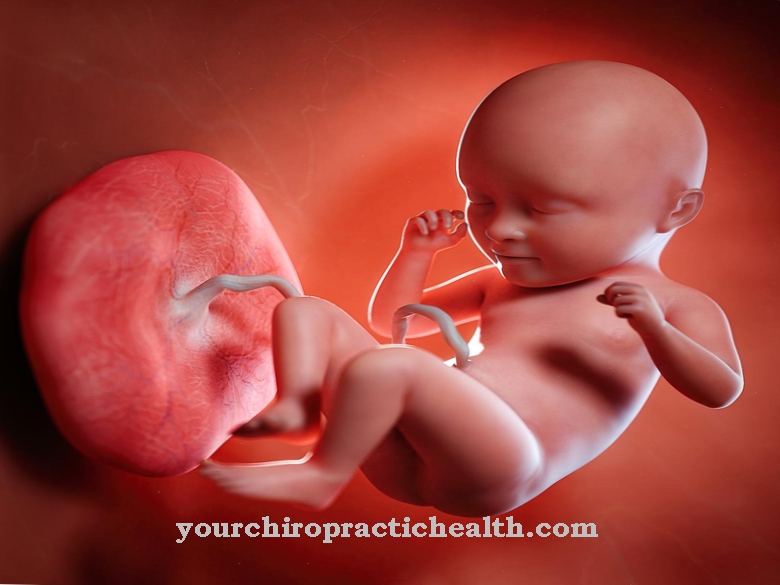The term Erdheim-Gsell syndrome includes a pathological change in the middle vessel wall (media) of the large arteries, mainly the aorta. The disease syndrome, usually referred to as idiopathic, leads to a breakdown of the smooth muscles and elastic fibers in the media. The changed elasticity of the media increases the risk of a life-threatening aortic dissection, especially in the ascending branch of the aorta and in the aortic arch, which can lead to aneurysm dissecans, hemorrhage and aneurysm formation between the inner and outer layer of the vessel wall.
What is Erdheim-Gsell Syndrome?

© designua - stock.adobe.com
With the term Erdheim-Gesell syndrome or cystic or mucoid median necrosis Erdheim-Gsell is a degenerative change in the media that affects the large arteries, especially the aorta. In the course of the disease, the smooth muscle fibers and elastic fibers in the media, the middle layer of the arterial vessel walls, break down.
The breakdown of the elastic fibers corresponds to an elastolysis and the breakdown of the smooth muscle cells usually takes place via apoptosis, the programmed cell death. The breakdown mechanism of the cells therefore does not correspond to the picture of necrosis. In the course of the disease, the media - and with it the affected artery itself - changes in its physical behavior.
The elasticity decreases sharply and the media can no longer actively react to signals for constriction or expansion because the corresponding smooth muscle cells are no longer available. This has a particularly serious effect in the ascending branch of the aorta and in the aortic arch, because the vessel walls in these sections of the aorta are exposed to particularly high elasticity requirements in order to fulfill their air pocket function.
causes
The cause of the Erdheim-Gsell syndrome has not yet been conclusively clarified, so that the disease is often also called idiopathic cystic median necrosis referred to as. The name addition idiopathic is of Greek origin and means something like "own" or "out of itself" and is used synonymously with the adjective essential in medicine. Idiopathic always means that the causes of the disease are not (yet) sufficiently known.
Some evidence suggests that genetic causes could play a role, such as in Marfan's syndrome, under which certain hereditary connective tissue diseases are summarized. So far, several chromosome regions have been identified which have an influence on the nature of the media and which are responsible for the breakdown of elastic fibers and for the incorporation of mucopolysaccharide-like deposits.
Other diseases such as hypothyroidism, hypercortisolism or long-term high blood pressure can also play a role. Hypercortisolism is an acquired disease caused by too long and too intense treatment with cortisone.
Symptoms, ailments & signs
Typical signs and symptoms that can indicate the Erdheim-Gsell syndrome are severe to very severe pain in the chest immediately behind the breastbone (sternum). The chest pain is usually accompanied by unspecific symptoms such as malaise, vomiting and agitation.
In cases where there are signs of shock and the chest pain is radiating to the back, it is very likely that a dissection aneurysm has already formed in the aorta and requires immediate treatment. Further symptoms arise due to the secondary damage caused by bleeding into the media with the simultaneous formation of a life-threatening aneurysm.
Diagnosis & course of disease
The Erdheim-Gsell syndrome causes hardly any symptoms in the initial stage, so that the disease was discovered by chance at this stage in the course of the investigation of certain complaints that do not have to be related to the Erdheim-Gsell syndrome. Symptoms only occur when the disease has progressed so far that the breakdown of muscle fibers and elastic fibers and the incorporation of mucopolysaccharides into the media result in dissections in the aorta.
Aortic dissection can be diagnosed using transesophageal echocardiography (TEE). However, other imaging diagnostic methods such as CT and MRT allow more differentiated and more precise statements. If left untreated, an aortic dissection usually develops into a life-threatening aneurysm if a tear forms in the inner vessel wall, the intima, through which blood can flow into the media.
When should you go to the doctor?
A general malaise in the organism that occurs suddenly and for no apparent reason should be clarified by a doctor. If you have symptoms such as vomiting, nausea or general weakness, there is cause for concern. Consult a doctor if symptoms persist for several days or weeks. In many cases the symptoms appear gradually over a longer period of time. Contact with a doctor should be established if the person concerned perceives a reduction in performance or a decrease in well-being. Restlessness or sleep disorders should be investigated and treated.
If there are disturbances in concentration, a diffuse feeling of anxiety or attention problems, a doctor's visit is necessary. Particular caution should be exercised if there is internal pressure or chest pain. To clarify the cause, it is advisable to see a doctor. If the pain reaches the back or spreads to the front of the body, a doctor should conduct a medical examination. Life-threatening conditions are imminent and should be presented to a doctor in good time. If there are bruises or discoloration of the skin in the chest area, a doctor's visit is necessary. If movements of the upper body can no longer be carried out as usual, it is advisable to consult a doctor.
Doctors & therapists in your area
Treatment & Therapy
A treatment that aims directly at curing Erdheim-Gesell syndrome does not exist. This is due to the fact that the relationships between the causal factors are not sufficiently understood and genetic factors are likely to be the cause. Treatment is therefore only considered when acute problems arise, such as with an aortic dissection.
In the ascending area of the aorta and in the aortic arch there are several important arterial branches that can be relocated by the dissection or actually shear off. For certain organs and body regions, the poor blood supply can result in serious or life-threatening situations without aneurysms having already formed. If aortic dissection is diagnosed without any acute danger, drug therapy is primarily aimed at lowering blood pressure.
It is important to reduce the systolic values below 140 mmHg in order to minimize the risk of an aneurysm. The main therapeutic measures available are vascular surgery, with the help of which - mostly using the heart-lung machine - vascular prostheses are inserted and torn or torn arteries are made mechanically functional again.
Outlook & forecast
In the worst case, Erdheim-Gsell syndrome can lead to death. For this reason, patients are always dependent on medical treatment to avoid further damage and complications. Without treatment, the disease is usually fatal and leads to a significantly reduced life expectancy for the patient.
Those affected suffer from severe chest pain as well as vomiting and a general feeling of illness. Anxiety also occurs frequently and significantly reduces the patient's quality of life. Many of those affected therefore also suffer from mental disorders. There is further bleeding and severe pain in the back. In severe cases, the Erdheim-Gsell syndrome can also lead to shock, in which the patient loses consciousness and can injure himself again if he falls.
An early diagnosis and treatment of Erdheim-Gsell syndrome has a very positive effect on the further course of the disease. With the help of medication, blood pressure can be lowered. However, most sufferers also need surgery to cure the disease completely.
prevention
There are no preventive measures that could minimize the risk of developing Erdheim-Gsell syndrome, because the disease may be multifactorial and the connections that ultimately trigger Erdheim-Gsell syndrome are not (yet) sufficiently understood . The most important preventive measures could be to have the aorta examined by ultrasound from time to time, if further cases of Erdheim-Gsell syndrome are known within the own family.
Aftercare
With Erdheim-Gsell syndrome, there are usually no special options for follow-up care available to those affected. The patient is primarily dependent on direct medical treatment of the disease in order to prevent further complications. In the worst case, if left untreated, the affected person can die, since heart failure usually occurs.
For this reason, an early diagnosis of Erdheim-Gsell syndrome is very important. In most cases, those affected with this disease are dependent on an operation. The patient must always rest after such an operation and take care of his body. In doing so, strenuous activities or other stressful or sporting activities should be avoided.
Strict bed rest is to be observed in order to accelerate the healing of Erdheim-Gsell syndrome. Most patients also depend on medication to lower their blood pressure. These should be taken regularly and in the right amount. In case of doubt, a doctor should always be consulted. Even after a successful operation, regular examinations by a doctor are necessary so that the symptoms of Erdheim-Gsell syndrome do not recur.
You can do that yourself
There is no alternative to conventional medicine for sick people to alleviate the symptoms of Erdheim-Gsell syndrome. The self-help measures are limited to a special duty of care with regard to one's own physical and emotional needs.
Patients with Erdheim-Gsell syndrome should protect themselves from overexertion and overload. Physical activities are to be adapted to the requirements and specifications of the organism. As soon as the blood pressure rises, immediate action is necessary. Relaxation techniques, rest and rest help to lower blood pressure. Patients who regularly use methods such as yoga, meditation or autogenic training experience a reduction in stress and an increase in inner calm. Balance and harmony strengthen the feeling of health and have a positive influence on the cardiovascular system. Music, hobbies or playing singing bowls are also helpful in order to improve well-being and to find an inner balance with everyday demands.
In everyday life, confrontations that are perceived as emotionally stressful should be avoided as far as possible. The optimization of one's own behavior, a de-escalating appearance and the development of various strategies for dealing with conflicts are particularly helpful. Cognitive training and the search for clarifying conversations can be used in problem solving. In addition, to relieve the heart activity, it should be ensured that the body weight is within the normal range of the BMI.



.jpg)























